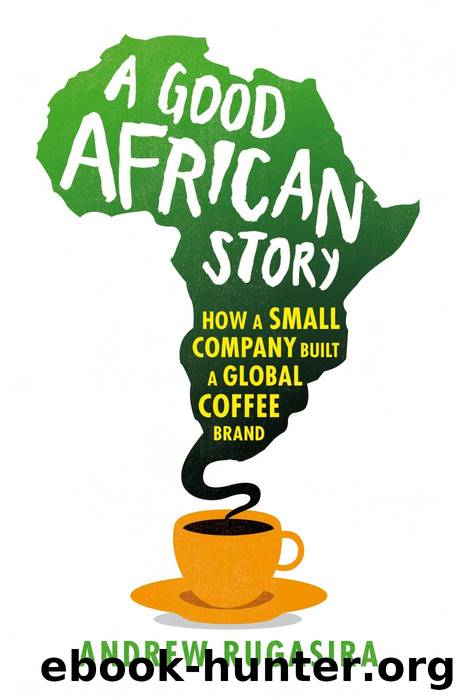A Good African Story by Andrew Rugasira

Author:Andrew Rugasira [Andrew Rugasira]
Language: eng
Format: epub
Publisher: Random House
Published: 2013-07-01T16:00:00+00:00
THE RUBBER HITS THE TARMAC
Between 2003 and 2008 I met with over two dozen financial institutions in Uganda and several outside the country in an effort to raise capital. There seemed to be a real disconnect between the excitement about the Good African Coffee model and my ability to close on the fundraising. Different financiers had different reasons for declining to support us. For some, it was that I was an ‘unknown quantity’ – what I was proposing sounded interesting but not fully assuring. For others, the model was just too complex. Controlling the whole coffee value chain, from the garden to the retail shelves, seemed like a stretch. It hadn’t been done before, so how could I be sure that I would succeed now? Kampala is a small town, and banks talk to one another about potential clients. As I racked up rejection after rejection, it became clear that chatter was fossilising into an opinion – I was not worth the risk.
I had something of a breakthrough in 2005 when, through Crane Bank, I was able to access the Ugandan Central Bank’s Export Credit Guarantee Scheme (ECGS). Crane Bank is a locally owned bank belonging to Sudhir Ruparelia, a Ugandan Asian tycoon with a diverse business portfolio. He is also one of the wealthiest, most hardnosed businessmen I know. He has established his empire through a combination of business acumen and street smarts. I first met him in the mid eighties when he ran a foreign exchange bureau in his shop on the main Kampala road. At the beginning of my UK school term, I would go to his shop and queue with other travellers and traders, to buy either US dollars or pound sterling on what was then an informal Forex market. Sudhir would be seated behind the counter doing the trades himself. He moved from informal financial services to establish a foreign exchange bureau after the liberalisation of the sector. He then set up a commercial bank, and built a diversified business portfolio that included numerous commercial and industrial properties, hotels and rose farms. Crane Bank quickly became adept at addressing the financial needs of many traders and other small to medium businesses; they did this through the speed of their loan-processing system, which had little bureaucracy. Of course, the speed with which loans are accessed is consistent with the swiftness with which defaulters are pursued.
The ECGS facility was created by the Central Bank to promote exports by providing guarantees for loans to enable exporters to fulfil their orders. The only problem was that it was a very short-term facility – a maximum of 180 days. It was designed for and utilised by traders and other commodity exporters who were able to complete their transactions within six-month cycles. Good African Coffee was a seriously long-term business in need of long-term and affordable capital. But at that time, we were not able to raise any capital and I was getting desperate. The UK launch was fast approaching and I didn’t have the funds to keep up with the frequent travel and the necessary set-up costs.
Download
This site does not store any files on its server. We only index and link to content provided by other sites. Please contact the content providers to delete copyright contents if any and email us, we'll remove relevant links or contents immediately.
| Arms Control | Diplomacy |
| Security | Trades & Tariffs |
| Treaties | African |
| Asian | Australian & Oceanian |
| Canadian | Caribbean & Latin American |
| European | Middle Eastern |
| Russian & Former Soviet Union |
The Secret History by Donna Tartt(16623)
The Social Justice Warrior Handbook by Lisa De Pasquale(11489)
Thirteen Reasons Why by Jay Asher(7788)
This Is How You Lose Her by Junot Diaz(5772)
Weapons of Math Destruction by Cathy O'Neil(5037)
Zero to One by Peter Thiel(4824)
The Myth of the Strong Leader by Archie Brown(4789)
Promise Me, Dad by Joe Biden(4447)
Beartown by Fredrik Backman(4419)
Stone's Rules by Roger Stone(4415)
How Democracies Die by Steven Levitsky & Daniel Ziblatt(4399)
The Fire Next Time by James Baldwin(4343)
100 Deadly Skills by Clint Emerson(4079)
A Higher Loyalty: Truth, Lies, and Leadership by James Comey(4033)
Rise and Kill First by Ronen Bergman(4012)
The David Icke Guide to the Global Conspiracy (and how to end it) by David Icke(3882)
The Farm by Tom Rob Smith(3872)
Secrecy World by Jake Bernstein(3782)
The Doomsday Machine by Daniel Ellsberg(3731)
